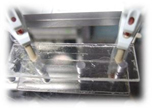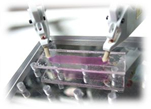We have developed a micro total analysis system (mTAS) for in-situ colorimetric water quality monitoring. The application of in-situ environmental monitoring necessitates a miniaturization of all parts of the system to reduce size and power consumption, allowing the device to be deployed for significant times (4-12 weeks) and in unique in-situ sampling situations such as wells and submersibles. This is a departure from the generally large and bulky benchtop equipment that is often used with mTAS. Environmental monitoring also requires that the device is able to perform an analysis reliably and autonomously under sampling conditions much harsher than the laboratory. Chips can not clog or foul, pumps must be stable and long-lived, and the analysis must be relatively insensitive to ionic strength and temperature fluctuations.
The device consists of a microfabricated filtration chip, miniature reagent storage baggies, an integrated micromixer and absorbance flow cell, micropumps, and microfluidic interconnects. These components are housed in a cylindrical waterproof package (2 ¾” diameter by 7” long). The device is intended to serve as a platform for several spectrophotometric methods of interest to water quality by simply changing the reagent. We have demonstrated its utility for measuring iron, which forms a redox couple in groundwater that is an important parameter in many biogeochemical sciences and iron is also thought to be a limiting nutrient in the primary production of the southern hemisphere’s oceans.
Iron was determined with the 1,10-orthophenanthroline method which requires a mixed reagent that simultaneously buffers the sample, reduces Fe (III) to Fe (II), and forms a chromophore with Fe (II). This mixed reagent provides for an accurate determination of iron over an adequate in-situ instrumentdeployment period of ~7.5 weeks. The device calibration was similar to a bench-top analysis and calibrations had good agreement over the 7.5 week time period. Determination of iron was performed on well water from an OSU wetland and compared well to a benchtop determination.
In order for the device to serve as a platform without reconfiguring the optics (source, detector, filters) it is necessary to have a broad-spectrum source and a multi-wavelength detector (which is also useful for spectral corrections and simultaneous multiple measurements). We are currently developing electronics and software so that the device can function autonomously. This includes a LED light source, a miniature spectrometer, pump drivers, control/computing circuitry, and power. All these components will also fit into the cylindrical packaging. The next phase of the project is to demonstrate in-situ ground water monitoring of iron in the wetland well with the autonomous mTAS. Work is also currently underway to adapt a spectrophotometric method for sulfide analysis to be performed with the device.
A new method has been developed for heavy metals extraction from water using a spiropyran modified PMMA microchip as a photoactivable microfluidic device. Although ion-exchange resins currently play important role in water purifications they unfortunately are consumed their used results in an increase in waste stream volume and constitutes a high recurring cost. The current work aims to provide a means for the removal of heavy ions from aqueous solution using spiropyran as a photoreversible compound to cycle the chelating moiety between binding and non-binding forms. Rather light will be used to trigger theirs binding and non-binding forms.
Spiro compounds are a well-known class of dyes that exhibit interesting photochromic functionality in that their structure changes reversibly with UV/visible irradiation. The photoinduced reaction of spiropyran involves the cleavage of the spiro carbon-oxygen bond upon UV light irradiation and subsequent isomerization to the open form. Spiropyran chemistry is applicable to extraction of metal ions by first chelating the ions (after the spiro compound is activated using UV light), and subsequently exposing the metal-spiropyran complex to visible light to elute contaminants efficiently in a concentrated plug.
 
A microfluidic device of PMMA anchored spiropyran non-binding form colorless under visible light (left) and PMMA anchored spiropyran binding form purple under UV light (right) |
Keys components of the project include:
- preparation and characterization of a solid supported spiropyran
- optimization of the solid supported spiropyran for lead removal
- incorporation of solid supported spiropyran into microfluidic device for the purpose of large volume water purification
The principle long term goal is the deployment of solar-powered microfluidic devices for the analysis and remediation of ground water.

